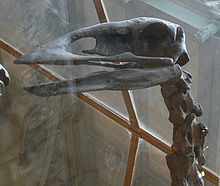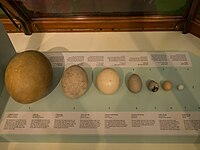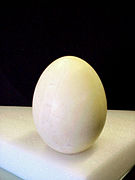Elephant bird
| Elephant birds Temporal range:
| |
|---|---|

| |
Aepyornis maximus skeleton and egg
| |
| Scientific classification | |
| Domain: | Eukaryota |
| Kingdom: | Animalia |
| Phylum: | Chordata |
| Class: | Aves |
| Infraclass: | Palaeognathae |
| Clade: | Novaeratitae |
| Order: | †Aepyornithiformes Newton, 1884[1] |
| Type species | |
| † Aepyornis maximus
, 1851 | |
| Genera | |
Elephant birds are extinct
Discovery
Elephant birds have been extinct since at least the 17th century. Étienne de Flacourt, a French governor of Madagascar during the 1640s and 1650s, mentioned an ostrich-like bird, said to inhabit unpopulated regions, although it is unclear whether he was repeating folk tales from generations earlier. In 1659, Flacourt wrote of the "vouropatra – a large bird which haunts the Ampatres and lays eggs like the ostriches; so that the people of these places may not take it, it seeks the most lonely places."[2][3] There has been speculation, especially popular in the latter half of the 19th century, that the legendary roc from the accounts of Marco Polo was ultimately based on elephant birds, but this is disputed.[4]
Between 1830 and 1840, European travelers in Madagascar saw giant eggs and eggshells.
Two whole eggs have been found in dune deposits in southern
Taxonomy and biogeography

Like the ostrich, rhea, cassowary, emu, kiwi and extinct moa, elephant birds were ratites; they could not fly, and their breast bones had no keel. Because Madagascar and Africa separated before the ratite lineage arose,[6] elephant birds has been thought to have dispersed and become flightless and gigantic in situ.[7]
More recently, it has been deduced from DNA sequence comparisons that the closest living relatives of elephant birds are New Zealand kiwi,[8] though the split between the two groups is deep, with the two lineages being estimated to have diverged from each other around 54 million years ago.[9]
Placement of Elephant birds within Palaeognathae, after:[10][11]
Paleognathae
|
| ||||||||||||||||||||||||||||||
The ancestors of elephant birds are thought to have arrived in Madagascar well after
Species
Up to 10 or 11 species in the genus Aepyornis have been described,[13] but the validity of many have been disputed, with numerous authors treating them all in just one species, A. maximus. Up to three species have been described in Mullerornis.[14] Recent work has restricted the number of elephant bird species to three, with two in Aepyornis, one in Mullerornis.[15]
- Order Aepyornithiformes Newton 1884 [Aepyornithes Newton 1884][13]
- Genus Aepyornis Geoffroy Saint-Hilaire 1850[16] (Synonym: Vorombe Hansford & Turvey 2018)
- Aepyornis hildebrandti Burckhardt, 1893 (Possibly divided into two subspecies[15])
- Aepyornis maximus Hilaire, 1851
- Genus Mullerornis Milne-Edwards & Grandidier 1894
- Mullerornis modestus (Milne-Edwards & Grandidier 1869) Hansford & Turvey 2018
- Genus Aepyornis Geoffroy Saint-Hilaire 1850[16] (Synonym: Vorombe Hansford & Turvey 2018)
All elephant birds are usually placed in the single family Aepyornithidae, but some authors suggest Aepyornis and Mullerornis should be placed in separate families within the Aepyornithiformes, with the latter placed into Mullerornithidae.[15]
Description
Biology

Examination of brain
Diet
Because there is no
Growth and reproduction
Elephant birds are suggested to have grown in periodic spurts rather than having continuous growth.
The eggs of Aepyornis are the largest known for any amniote, and have a volume of around 5.6–13 litres (12–27 US pt), a length of approximately 26–40 centimetres (10–16 in) and a width of 19–25 centimetres (7.5–9.8 in).[18] The largest Aepyornis eggs are on average 3.3 mm (1⁄8 in) thick, with an estimated weight of approximately 10.5 kilograms (23 lb).[15] Eggs of Mullerornis were much smaller, estimated to be only 1.1 mm (3⁄64 in) thick, with a weight of about 0.86 kilograms (1.9 lb).[15] The large size of elephant bird eggs means that they would have required substantial amounts of calcium, which is usually taken from a reservoir in the medullary bone in the femurs of female birds. Possible remnants of this tissue have been described from the femurs of A. maximus.[18]
Extinction
It is widely believed that the extinction of elephant birds was a result of human activity. The birds were initially widespread, occurring from the northern to the southern tip of
A 2021 study suggested that elephant birds, along with the Malagasy hippopotamus species, became extinct in the interval 800-1050 AD (1150–900 years
See also
- Late Quaternary prehistoric birds
- Holocene extinction
- Horton Hatches the Egg
References
- ^ Brands, S. (2008)
- ^ Etienne de Flacourt (1658). Histoire de la grande isle Madagascar. chez Alexandre Lesselin. p. 165. Retrieved 21 May 2013.
- ^ a b c Ley, Willy (August 1966). "Scherazade's Island". For Your Information. Galaxy Science Fiction. pp. 45–55.
- ^ S2CID 203423023.
- ^ Long, J. A.; Vickers-Rich, P.; Hirsch, K.; et al. (1998). "The Cervantes egg: an early Malagasy tourist to Australia". Records of the Western Australian Museum. 19 (Part 1): 39–46. Retrieved 24 April 2014.
- ^ Yoder, A. D. & Nowak, M. D. (2006)
- ^ van Tuinen, M. et al. (1998)
- S2CID 206555952.
- ^ PMID 28089793.
- PMID 37227001.
- PMID 33287726.
- S2CID 59466434.
- ^ a b Brodkorb, Pierce (1963)
- ^ Davies, S. J. J. F. (2003)
- ISBN 978-1-4081-5861-6.
- ISBN 978-1-78548-136-9, retrieved 2 May 2023
- ^ ISSN 0024-4066.
- ISBN 978-1-4081-5725-1.
- S2CID 88784039.
- S2CID 198384367.
- PMID 30381378.
- ^ Dransfield, J. & Beentje, H. (1995)
- PMID 35414222.
- ^ .
- S2CID 85920479.
- ^ Hawkins, A. F. A. & Goodman, S. M. (2003)
- PMID 30214938.
- S2CID 195555955.
- S2CID 236313083.
Further reading
- "One minute world news". BBC News. 25 March 2009. Retrieved 26 March 2009.
- Presenter: David Attenborough; Director: Sally Thomson; Producer: Sally Thomson; Executive Producer: Michael Gunton (2 March 2011). BBC-2 Presents: Attenborough and the Giant Egg. BBC. BBC Two.
- Brands, Sheila J. (1989). "The Taxonomicon : Taxon: Order Aepyornithiformes". Zwaag, Netherlands: Universal Taxonomic Services. Archived from the original on 21 April 2008. Retrieved 21 January 2010.
- Brands(a), Sheila (14 August 2008). "Systema Naturae 2000 / Classification, Genus Aepyornis". Project: The Taxonomicon. Archived from the original on 3 March 2009. Retrieved 4 February 2009.
- Brodkorb, Pierce (1963). "Catalogue of Fossil Birds Part 1 (Archaeopterygiformes through Ardeiformes)" (PDF). Bulletin of the Florida State Museum, Biological Sciences. 7 (4). Gainesville, FL: University of Florida: 179–293.
- Cooper, A.; Lalueza-Fox, C.; Anderson, S.; Rambaut, A.; Austin, J.; Ward, R. (8 February 2001). "Complete Mitochondrial Genome Sequences of Two Extinct Moas Clarify Ratite Evolution". Nature. 409 (6821): 704–707. S2CID 4430050.
- Davies, S. J. J. F. (2003). "Elephant birds". In Hutchins, Michael (ed.). Grzimek's Animal Life Encyclopedia, Vol. 8: Birds I Tinamous and Ratites to Hoatzins (2nd ed.). Farmington Hills, MI: Gale Group. pp. 103–104. ISBN 978-0-7876-5784-0.
- Dransfield, John; Beentje, Henk (1995). The Palms of Madagascar. Kew, Victoria, Australia: Royal Botanic Gardens. ISBN 978-0-947643-82-9.
- Flacourt, Etienne de.; Allibert, Claude (2007). Histoire de la grande île de Madagascar (in French). Paris, FR: Karthala. ISBN 978-2-84586-582-2.
- Goodman, Steven M. (1994). "Description of a new species of subfossil eagle from Madagascar: Stephanoaetus (Aves: Falconiformes) from the deposits of Ampasambazimba". Proceedings of the Biological Society of Washington (107): 421–428.
- Goodman, S. M.; Rakotozafy, L. M. A. (1997). "Subfossil birds from coastal sites in western and southwestern Madagascar". In Goodman, S. M.; Patterson, B. D. (eds.). Natural Change and Human Impact in Madagascar. Washington, DC: Smithsonian Institution Press. pp. 257–279. ISBN 978-1-56098-683-6.
- Hawkins, A. F. A.; Goodman, S. M. (2003). Goodman, S. M.; Benstead, J. P. (eds.). The Natural History of Madagascar. University of Chicago Press. pp. 1026–1029. ISBN 978-0-226-30307-9.
- Hay, W. W.; DeConto, R. M.; Wold, C. N.; Wilson, K. M.; Voigt, S. (1999). "Alternative global Cretaceous paleogeography". In Barrera, E.; Johnson, C. C. (eds.). Evolution of the Cretaceous Ocean Climate System. Boulder, CO: Geological Society of America. pp. 1–47. ISBN 978-0-8137-2332-7.
- LePage, Dennis (2008). "Aepyornithidae". Avibase, the World Bird Database. Retrieved 4 February 2009.
- MacPhee, R. D. E.; Marx, P. A. (1997). "The 40,000 year plague: humans, hyperdisease, and first-contact extinctions". In Goodman, S. M.; Patterson, B. D. (eds.). Natural Change and Human Impact in Madagascar. Washington, DC: Smithsonian Institution Press. pp. 169–217.
- Megiser, H. (1623). Warhafftige ... so wol Historische als Chorographische Beschreibung der ... Insul Madagascar, sonsten S. Laurentii genandt (etc.). Leipzig: Groß.
- Mlíkovsky, J. (2003). "Eggs of extinct aepyornithids (Aves: Aepyornithidae) of Madagascar: size and taxonomic identity". Sylvia. 39: 133–138.
- Pearson, Mike Parker; Godden, K. (2002). In search of the Red Slave: Shipwreck and Captivity in Madagascar. Stroud, Gloucestershire: The History Press. ISBN 978-0-7509-2938-7.
- van Tuinen, Marcel; Sibley, Charles G.; Hedges, S. Blair (1998). "Phylogeny and Biogeography of Ratite Birds Inferred from DNA Sequences of the Mitochondrial Ribosomal Genes". Molecular Biology and Evolution. 15 (4): 370–376. PMID 9549088.
- Yoder, Anne D.; Nowak, Michael D. (2006). "Has Vicariance or Dispersal Been the Predominant Biogeographic Force in Madagascar? Only Time Will Tell". Annual Review of Ecology, Evolution, and Systematics. 37: 405–431. .




